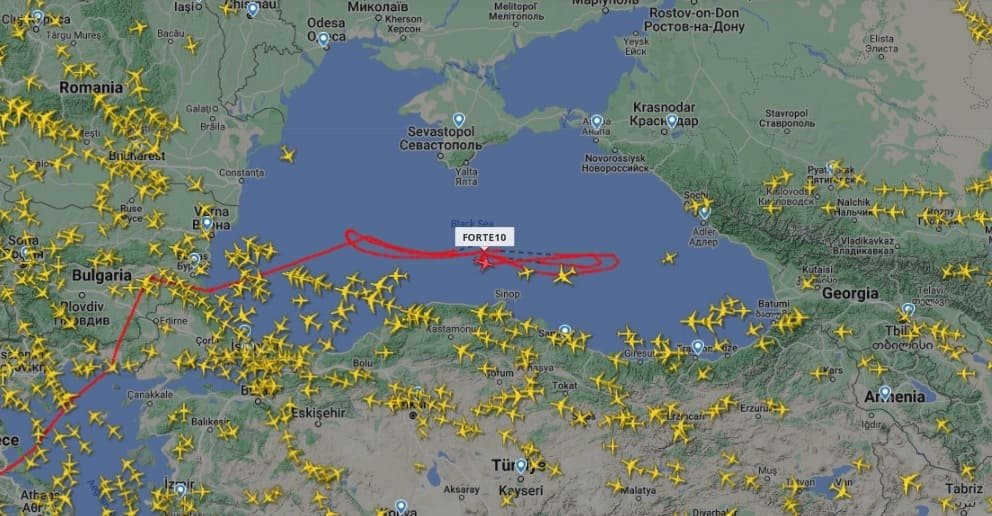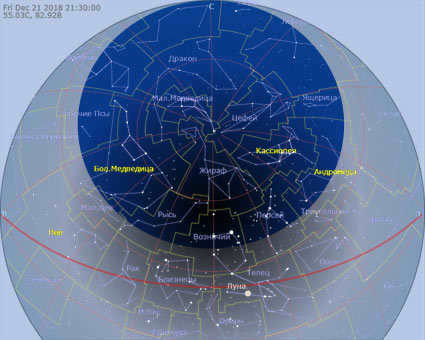
Displayed on this page is a celestial map that generates a depiction of the night sky based on the present time and specified coordinates, and it also allows for adjustments to both the date and geographical location.
In Novosibirsk, the center of the city is known as Lenin Square. The precise coordinates on the star map are 55.03° north latitude and 82.92° east longitude (55°01'00" N 82°55'00" E).
When using the map, it is important to consider that the local time in Novosibirsk is different from Moscow time, which is calculated from the Greenwich meridian, by an average of 2 hours and 30 minutes. Additionally, it differs from the local zonal time by 1 hour and 30 minutes. It is also worth noting that the calculations for the starry sky are based on the time set on your device.
Figure 1 depicts the winter starry sky and the area of stars that never set at the latitude of Novosibirsk*. There are 5 constellations within this area that do not go beyond its boundaries:
Little Bear; Dragon; Cassiopeia; Giraffe and Cepheus – they are referred to as the non-setting constellations.
Regardless of their position on the star map (Fig.2), the non-setting constellations always remain visible.
Online planetarium
Fig.2. Map showing the stars above Novosibirsk – click on the “Expand” icon in the top right corner to enlarge the map. You can also adjust the time and geographic coordinates in the top left corner of the map.
To activate real-time mode, click on the sky image to enable the cross-shaped cursor. Then, switch your keyboard to the Latin font and press the “8” button to set the current time. Finally, press the “l” button (lowercase L). Please note that enabling real-time mode on your mobile device may consume a lot of energy.
Constellations that do not appear in the middle and subtropical latitudes create a compact, small group, so there is no need to determine their order.
However, in groups that consist of a large number of constellations, it is recommended for observers to enumerate them based on their proximity, in a counterclockwise order along the plane of the celestial equator. In this case, the most convenient reference line is not the prime meridian, but the line that passes through Polaris, Dubhe, and Merak of the Big Dipper (Fig. 3) – if these stars are barely distinguishable due to atmospheric conditions, then in such a sky, it will be impossible to see anything other than the Moon.
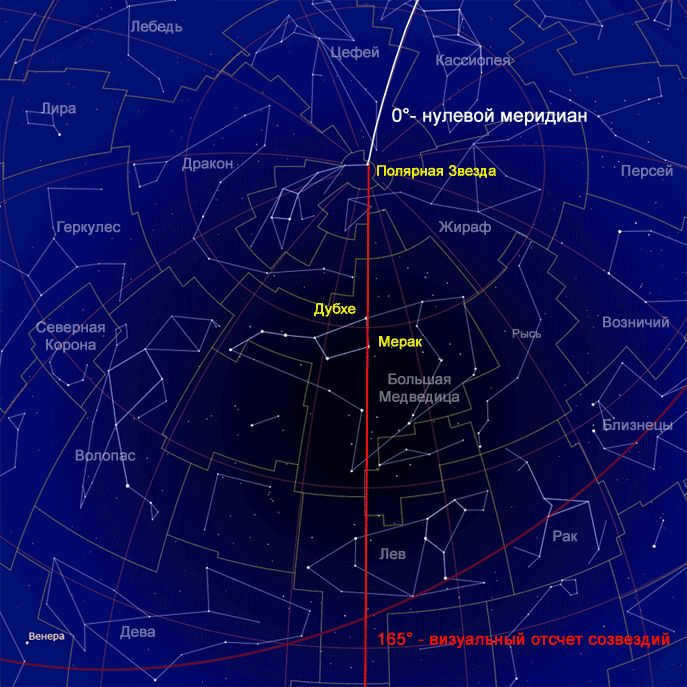
Fig.3. The starry sky, the prime meridian (white) and the line indicating the start of the visual counting of constellations (red) serve as a useful guide to locate Polaris and the Little Dipper.
To the immediate south of the non-setting constellations, there are partially setting constellations which have at least one star falling within the circumpolar circle of non-setting stars.
Novosibirsk’s sky contains a total of 16 partially setting constellations (counting clockwise from the reference line):
1. the Big Dipper;
2. Small Lion;
3. Hound Dogs;
4. Wolopassus;
5. Northern Crown;
6. Hercules;
7. Lyra;
8. Swan;
9. Lizard;
10. Andromeda;
11. Pegasus;
12. Perseus;
13. Triangle;
14. The Ascendant;
15. Gemini;
16. Lynx.
Continuing further south, you will come across a series of constellations that are fully visible and recognized by the International Astronomical Union.
Below Novosibirsk, there are a total of 27 constellations in the following order:
1. Leo;
2. Sextant;
3. Cup;
4. Virgo;
5. Raven;
6. Veronica’s hair;
7. Libra;
8. Snake-1;
9. Serpentine;
10. Shield;
11. Eagle;
12. Arrow;
13. Fox;
14. Capricorn;
15. Dolphin;
16. Aquarius;
17. M. Horse;
18. Pisces;
19. Whale;
20. Aries;
21. Taurus;
22. Orion;
23. Hare;
24. Unicorn;
25. Big Dog;
26. M. Dog;
27. Cancer.
And there are partially visible constellations on the southernmost horizon, where occasionally a star can be seen emerging from behind the horizon.
Throughout the year, there are 15 partially visible constellations in the starry sky of Novosibirsk:
1. Hydra;
2. Compass;
3. Pump;
4. Centaurus;
5. Wolf;
6. Scorpion;
7. Sagittarius;
8. Microscope;
9. Southern Fish;
10. Eridanus;
11. Furnace;
12. Sculptor;
13. Chisel;
14. Dove;
15. Feed.
Therefore, a total of 63 constellations can be observed in the sky of Novosibirsk! It is most convenient to check for the presence or absence of constellations in an alphabetical list, so here is an alphabetical list of constellations visible in the sky of Novosibirsk:
Andromeda, Gemini, Big Dipper, Ursa Major, Libra, Aquarius, Aquarius, Ascendant, Wolf, Volopassus, Veronica’s Hair, Raven, Hercules, Hydra, Dove, Hound Dogs, Virgo, Dolphin, Dragon, Unicorn, Giraffe, Hare, Serpent, Snake, Cassiopeia, Whale, Capricorn, Compass, Corma, Swan, Lion, Lyra, Fox, M. Horse, M. Dog, Little Leo, Little Bear, Microscope, Pump, Aries, Eagle, Orion, Pegasus, Perseus, Furnace, Cancer, Incisor, Pisces, Lynx, North Crown, Sextant, Scorpio, Sculptor, Sagittarius, Sagittarius, Taurus, Triangle, Centaurus, Cepheus, Cup, Shield, Eridanus, South Fish, Lizard
Novosibirsk offers a unique experience for stargazers in the form of a specific set of constellations that can be observed at midnight culmination. These constellations include Andromeda, Gemini, Big Dipper, Ursa Major, Libra, Aquarius, Aquarius, Ascendant, Wolf, Volopassus, Veronica’s Hair, Raven, Hercules, Hydra, Dove, Hound Dogs, Virgo, Dolphin, Dragon, Unicorn, Giraffe, Hare, Serpent, Snake, Cassiopeia, Whale, Capricorn, Compass, Corma, Swan, Lion, Lyra, Fox, M. Horse, M. Dog, Little Leo, Little Bear, Microscope, Pump, Aries, Eagle, Orion, Pegasus, Perseus, Furnace, Cancer, Incisor, Pisces, Lynx, North Crown, Sextant, Scorpio, Sculptor, Sagittarius, Sagittarius, Taurus, Triangle, Centaurus, Cepheus, Cup, Shield, Eridanus, South Fish, and Lizard. These constellations provide the best conditions for visual observation.
From January 29 to April 28, the constellation that passes through the zenith is the Big Dipper. From April 28 to July 8, it is the Dragon. From July 8 to August 21, the Swan takes its turn. From August 21 to August 24, Cepheus is the constellation that passes through the zenith. From August 24 to September 4, it is the Lizard. From September 4 to October 18, the constellation that passes through the zenith is Cassiopeia. From October 18 to November 12, it is Perseus. From November 15 to December 9, the Giraffe is the constellation that passes through the zenith. From December 9 to December 25, it is the Chariot. And finally, from December 25 to January 29, the constellation that passes through the zenith is the Lynx.
In total, there are 10 constellations that pass through the zenith.
Observing the Night Sky in Novosibirsk
Virtual Mini Planetarium
Interactive Star Map for Novosibirsk: Constellation Borders and Names
Keyboard Shortcuts for Controlling the Online Star Map:
(use cursor and Latin keyboard layout)
- a → Toggle Atmospheric Simulation
- g → Adjust Horizon
- h → Change Map View
- i → Invert Colors
- , → Show Ecliptic
- ; → Draw Meridian Line
- e → Show Equatorial Grid
- z → Show Azimuthal Grid
- m → Show Galactic Grid
- M → Show Milky Way Boundaries
- q → Hide World Sides
- s → Hide Stars
- S → Hide Star Names
- u → conceal the names of celestial bodies
- p → hide celestial bodies and the Sun
- o → reveal the paths of celestial bodies
- c → display diagrams of constellations
- v → hide names of constellations
- b → hide boundaries of constellations
- R → reveal meteor shower radians
- 8 → set the current time
- j → slow down the passage of time
- k → pause the passage of time
- l → speed up the countdown
- – → go back one day
- = → go forward one day
- [ → go back one week
- ] → go forward one week
- % → rotate counterclockwise
- ‘ → rotate clockwise
- & → show dim stars
- ( → hide dim stars
1 or ? → display this list on the celestial map
Sergey Ov (Seosnews9)
11.07. 2018 – Work on this page will continue:
Abstracts:
– Constellations passing through the zenith ✔
– Constellations, asterisms and seasons
– Panorama map of the entire part of the starry sky accessible for viewing from Novosibirsk.
* The starry sky looks similar at similar latitudes. Generally, the visual similarity is preserved even with a slight deviation of 1-2° in latitude. For example, the sky in Novosibirsk will have a similar appearance to cities like Kemerovo, Krasnoyarsk, Severobaikalsk, Belfast, Glasgow, Edinburgh, Copenhagen, Klaipeda, Vitebsk, Moscow, Vladimir, Cheboksary, Kazan, Naberezhnye Chelny, Chelyabinsk, Kurgan, and Omsk. To achieve an exact match between the virtual map and the real sky, you only need to enter the time correction or coordinates of the corresponding city in the upper left corner of the star map.
Regional star maps are specifically designed for large cities and popular resort destinations.
Moscow: Explore the starry sky above Moscow with our online mini planetarium.
St. Petersburg: Discover the celestial wonders of St. Petersburg with our web planetarium.
Nizhny Novgorod: Immerse yourself in the starry sky of Nizhny Novgorod with our online planetarium.
Novosibirsk: Journey through the constellations above Novosibirsk with our online planetarium.
Yekaterinburg: Experience the beauty of the starry sky above Yekaterinburg with our web-planetarium.
Kazan: Explore the starry sky over Kazan with our planetarium, featuring online settings.
Krasnodar: Marvel at the starry sky above Krasnodar with our JavaScript planetarium.
Samara: Discover the celestial wonders of Samara with our online planetarium.
Krasnoyarsk: Journey through the constellations above Krasnoyarsk with our JavaScript planetarium.
Chelyabinsk: Explore the starry sky above Chelyabinsk with our JS planetarium.
Omsk: Calculate the constellation patterns in the starry sky above Omsk with our online tool.
Perm: Chart the constellations in the starry sky above Perm with our online calculation tool.
Voronezh: Map out the starry sky over Voronezh with our online constellation mapping tool.
Murmansk: Starry Sky Map over Murmansk – Virtual Planetarium
Vladivostok: Starry Sky Map over Vladivostok – JavaScript Planetarium
Petropavlovsk-Kamchatsky: Starry Sky Map over Petropavlovsk-Kamchatsky – Online Planetarium
Sochi: Starry Sky Map over Sochi – Online Planetarium Software
Crimea: Starry Sky Map over Crimea – Online Planetarium.
Pages are planned to be created for the following cities: Chelyabinsk, Omsk, Rostov-on-Don, Ufa, Perm, Voronezh, Volgograd, Saratov, Kaliningrad, Sevastopol, Tyumen.
Pages have been created for “Starry Sky” – Chelyabinsk, Omsk, Perm, Voronezh.
Interactive map of the starry sky of a specific area at a specific time:
Working hours: 10:00 to 21:00,
Closed on Tuesdays
“Retro-cafe”: operates from 10:00 to 20:00 during Planetarium working days.
+7 (495) 221-76-90
Planetarium JSC © 2017. Moscow, Sadovaya-Kudrinskaya street 5, building 1
Astronomy forecast for August 2023

Date: 26.07.2023
August is the month that brings the much-awaited Perseid meteor shower, the opposition of Saturn, and the rare occurrence of a blue super moon in 2023.
Notable milestones in August 2023:
75th anniversary of Svetlana Evgenievna Savitskaya.
90 years since the launch of the first Soviet rocket (GIRD 09) with hybrid fuel.
140th anniversary of the birth of Leonid Alekseevich Kulik.
20 years since the launch of the Spitzer space telescope.
65th anniversary of Sergey Konstantinovich Krikalev.
Perseids – the summer’s celestial fireworks!
The meteor shower from the constellation Perseus will be visible throughout August. The peak of the shower will occur from August 11 to August 13, with approximately 100 meteors per hour at its zenith. The conditions for observing the Perseids in 2023 are favorable, as the Moon will be approaching the new moon on August 16, 2023, and will not interfere with meteor observations.
On August 13, Venus will be in a lower (inner) conjunction with the Sun.
On August 27, Saturn will be in opposition to the Sun.
August 2023 is the perfect time to observe the magnificent giant planets, Jupiter and Saturn.
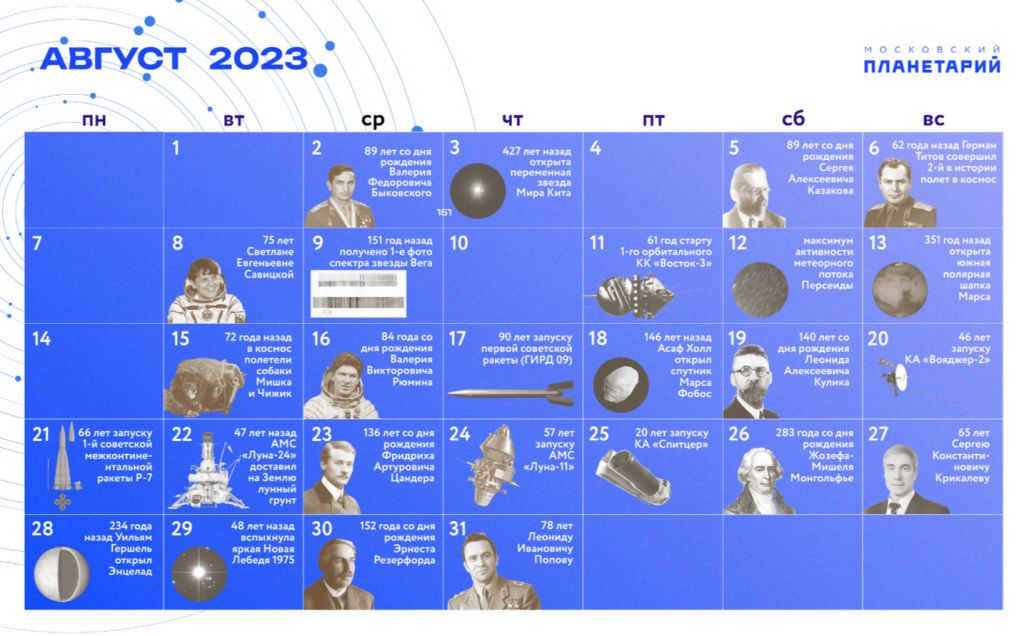
August 2023 Calendar
Exciting Dates and Events in Astronomy and Astronautics for August 2023:
August 5 – 150 years, On 5.08.1873, marks the 150th anniversary of the birth of Sergey Alexeyevich Kazakov, a renowned Russian and Soviet astronomer. Throughout his career, Kazakov was closely associated with Moscow University, where he served as a professor and worked at the university observatory. His scientific contributions mainly revolve around theoretical astronomy and astrometry. Notably, he authored two university textbooks focusing on theoretical and spherical astronomy.
August 8 – 75 years On August 8, 1948, we commemorate the 75th anniversary of the birth of Svetlana Evgenievna Savitskaya, the second woman-cosmonaut in the world and the first woman to venture into outer space. Savitskaya, a pilot-cosmonaut of the USSR, holds the distinction of being a two-time Hero of the Soviet Union. She successfully completed two space missions onboard Soyuz T-7-Salyut-7 (1982) and Soyuz T-12-Salyut-7 (1984).
August 13 – 125 years August 13, 1898, marks the 125th anniversary of the birth of Carl Gustav Witt, a prominent German astronomer recognized for his contributions to astrophotography and the discovery of the asteroid Eros.
August 17 – 90 years On August 17, 1933, the first Soviet rocket, known as GIRD 09 and designed by M.K. Tikhonravov in Nakhabino, was launched. This historic rocket, powered by hybrid fuel, reached a height of 400 meters.
August 19 – 140 years On August 19, 1883, we commemorate the 140th anniversary of the birth of Leonid Alekseevich Kulik, a notable Soviet specialist in mineralogy and meteorite research who extensively studied the Tunguska phenomenon.
August 20 – 100 years On 20.08.1923, the Astronomical Institute was established through the merger of the Computational and Astronomical-Geodesic Institutes in Leningrad. In 1943, it underwent reorganization and became the Institute of Theoretical Astronomy (ITA) under the USSR Academy of Sciences. Recognized as an international center for the study of minor planets by the International Astronomical Union since 1948, the ITA eventually became part of the current Institute of Applied Astronomy of the Russian Academy of Sciences in 1998. The institute publishes Russian and international yearbooks containing ephemerides of various celestial bodies, while also conducting research on novel methods of astrometry and geodynamics, celestial mechanics, radio interferometry, space geodesy, and fundamental coordinate-time support.
August 25 – 20 years Twenty years ago, on August 25, 2003, the Spitzer space telescope, also known as Spitzer, was launched.
August 27 – 65 years, On 27.08.1958, we celebrate the 65th anniversary of the birth of Sergey Konstantinovich Krikalev. Sergey Konstantinovich is a distinguished pilot-cosmonaut of the USSR, as well as a Soviet and Russian aviation sportsman. From October 2005 to June 2015, he held the record for the most cumulative time spent in space. Krikalev is a recipient of the Hero of the Soviet Union and Hero of the Russian Federation titles, having completed six space missions on various spacecraft, including SoyuzTM-7-Mir (1988-1989), SoyuzTM-12-Mir-Soyuz TM-13 (1991-1992), Discovery-18-Mir (1994), Endeavor-MKS (1998), SoyuzTM-31-MKS-Discovery (2000-2001), and SoyuzTMA-6-MKS (2005). Notably, he was a member of the crew for the first long-term expedition to the International Space Station (ISS).
August 2023 Astronomical Celestial Calendar
This review provides the astronomical events for August 2023 according to Moscow time. Tmsk = UT + 3h (where UT is Universal Time).
The Moon is represented by various phases such as F (0.0+-): F = 0.00 (new moon), F = 0.50+ (first quarter), 1.00 (full moon), F = 0.50- (last quarter); for luminaries, their stellar magnitude is indicated as +-0.0m.
The Perseids meteor shower is active throughout the entire month of August, with its peak of activity occurring on the night of August 11-12. The presence of the new moon during this time will not interfere with meteor observations.
On August 1 (21:33 Moscow time), there will be a Full Moon.
On August 2, the Moon will be at perigee of its orbit, at a distance of 357,309 km from Earth, with an apparent diameter of 33 arc minutes and 27 arc seconds. This will occur at 08:53.
Starting from August 3, Neptune will become visible during the nighttime.
On August 3, the Moon will pass 2.5° south of Saturn (+0.6m) at 15:00.
At 02:00 on August 5, the Moon will pass 1° south of Neptune (+7.8m).
On August 8, Venus will reach its aphelion.
At 11:00 on August 8, the Moon will pass 2.9° north of Jupiter (-2.4m).
On August 8 (13:30 Moscow time), there will be a last quarter Moon.
At 03:00 on August 9, the Moon will pass 2° north of Uranus (+5.8m).
During the same day, the Moon will also pass 1.5° south of the Pleiades star cluster (M45).
On August 10, Mercury will reach its maximum eastern (evening) elongation, at 27.4° (evening) at 05:00.
On August 10, Mercury will also reach its aphelion.
At 11:00 AM on August 10, the Moon will pass 9° north of Aldebaran (+0.9m).
On August 11/12, the Perseids meteor shower will reach its maximum activity (ZHR=100), with the Moon near the new moon (08/16/2023). The radiant will be visible all night and will not set.
The Perseids meteor shower is highly popular due to its occurrence on warm August nights in the Northern Hemisphere. It is active annually from July 14 to September 1. The Perseids typically reach their peak on August 11, 12, or 13, depending on the year. Under normal observing conditions in rural areas, the number of meteors can range from 50 to 75 per hour at the zenith. The Perseids are particles released by comet 109P/Swift-Tuttle during its numerous returns within the solar system. They are named Perseids because their radiant (the region from which the meteors appear to depart) is located in the constellation Perseus. On the night of the peak, the IMO (International Meteor Organization) predicts up to 100 meteors per hour, and the radiant will be visible all night and will not set. The conditions for meteor sightings in 2023 are favorable, thanks to the new moon occurring on August 16, 2023.
At 09:00 on August 13, Mercury (+0.48m) will pass 4.7° south of Mars (+1.78m).
On August 13, there will be a lower (inner) conjunction of Venus with the Sun at 14:00.
At 01:00 on August 14, the Moon will pass 2° south of Pollux (+1.2m).
During the same day, the Moon will also pass north of the scattered star cluster Nursery (M44).
On August 15, the Moon will pass north of Venus.
On August 16 (12:39 Moscow time), there will be a New Moon.
On August 16, the Moon will be at the apogee of its orbit, at a distance of 406,634 km from Earth, with an apparent diameter of 29 arc minutes and 23 arc seconds. This will occur at 14:56 PM.
During the same day, the Moon will also pass north of Regulus.
At 21:00 on August 18, the Moon will pass 5° north of Mercury (+0.7m).
At 03:30 on August 19, the Moon will pass 2.2° north of Mars (+1.78m).
At 21:17 on August 21, the Moon will pass 2° north of Spica (+1.0m).
On August 23, the Southern Delta Aquariids meteor shower will come to an end.
At 21:45 on August 23, Mercury (+0.48m) will become stationary and transition from direct to retrograde motion.
Starting from August 24, Venus will become visible during the morning.
On August 24 (12:58 Moscow time), there will be a first quarter Moon.
At 05:00 on August 25, the Moon will pass 1° north of Antares (+1.1m). This event will be visible in North America, specifically from the USA, Mexico, and Canada, and will be referred to as the Lunar eclipse of Antares.
On August 27, Saturn (+0.2m) will be in opposition to the Sun at 12:00.
On August 29, Uranus (+5.78m) will be in opposition and will transition from direct to retrograde motion at 07:00.
On August 30, the Moon will be at the perigee of its orbit, at a distance of 357,181 km from Earth, with an apparent diameter of 33 arc minutes and 27 arc seconds. This will occur at 18:52.
At 23:00 on August 30, the Moon will pass 2.5° south of Saturn (+0.4m).
On August 31 (04:37 Moscow time), there will be a Full Moon – the SUPERMOON of the year!
Starry Skies in August
Located in the zenith region, you can find the constellation Cepheus, with Cassiopeia to the east and Perseus below.
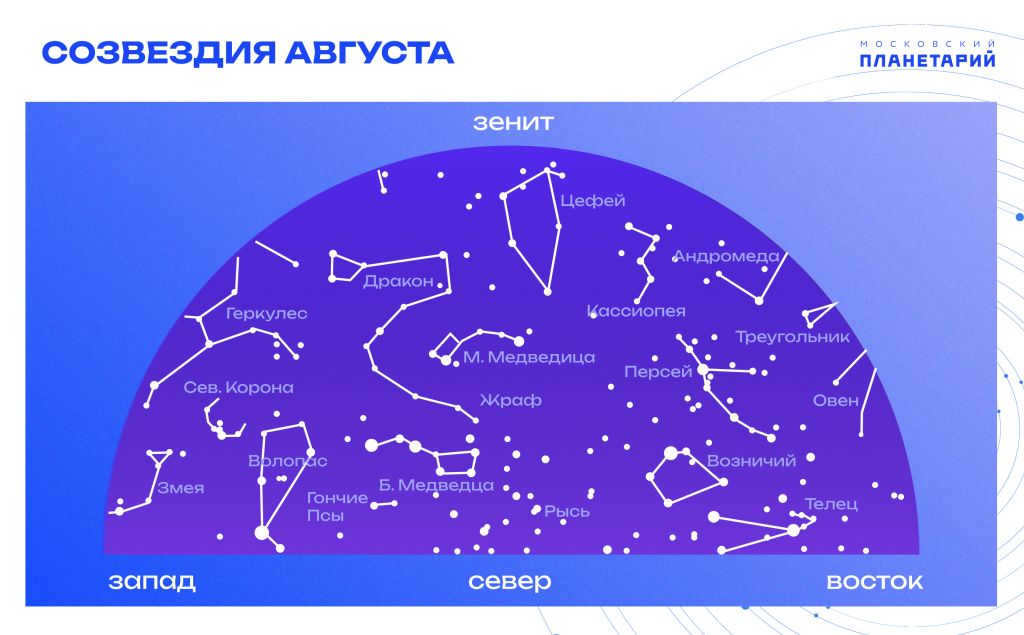
The stunning constellations of Cassiopeia, Perseus, and Ascendant can be seen in the northeastern sky, while Taurus is located near the horizon.
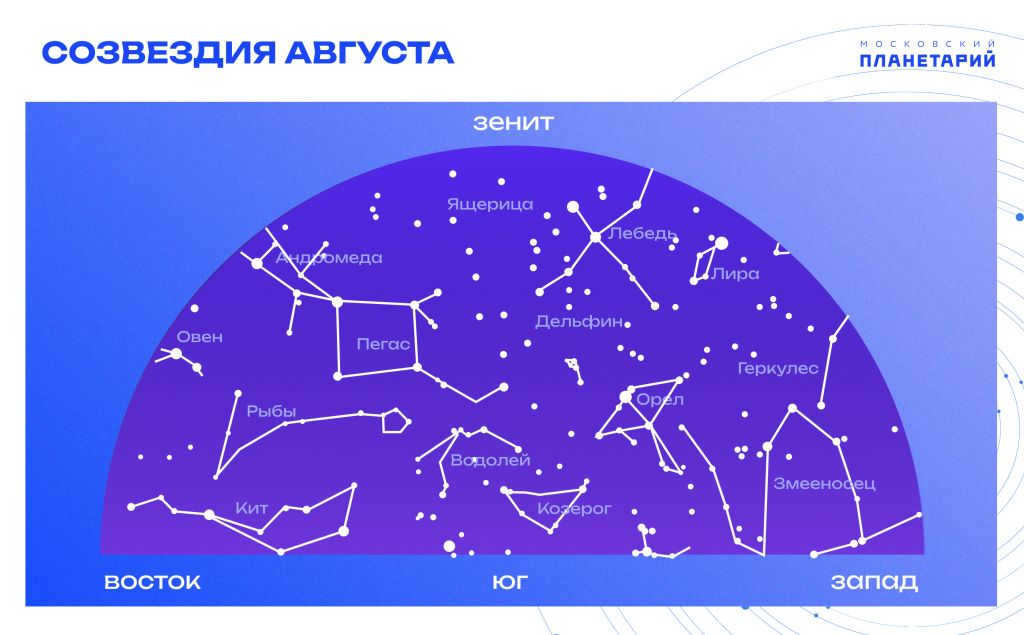

The southern part of the celestial sphere is dominated by the Summer Triangle, which is made up of the bright stars Vega, Deneb, and Altair. These stars are the main attractions of the constellations Lyra, Cygnus, and Aquila, respectively. Near the horizon, you can also spot the constellation Serpens. Additionally, in this region of the sky, you can find smaller but fascinating constellations like Sagitta, Vulpecula, and Delphinus. Further towards the horizon, you’ll come across the southern constellations Sagittarius and Capricornus. Moving towards the southeast, at a high altitude, you’ll encounter Andromeda and Pegasus, while closer to the horizon, you’ll see Pisces and Cetus. To the west of the zenith, you can observe Draco, Hercules, and Serpens. Lastly, the Milky Way stretches from the south to the northeast, passing by the zenith.
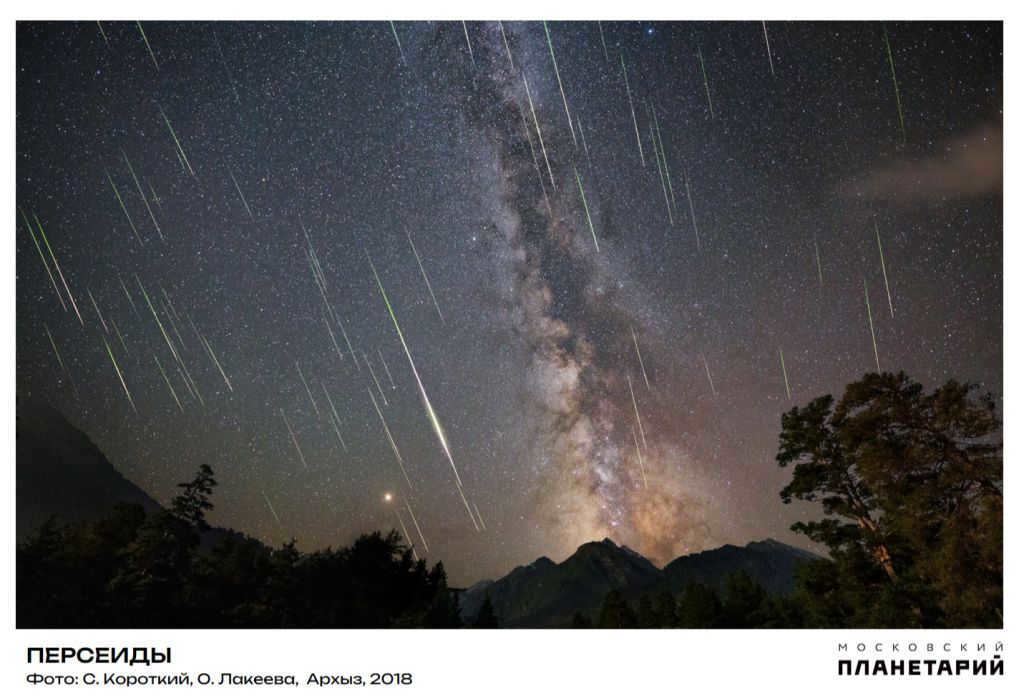

Perseids 2023.
During the month of August, there will be a spectacular meteor shower known as the Perseids. This annual event takes place from July 14 to September 1, with the peak occurring on the night of August 11-12. The Perseids can be observed from the constellation Perseus and are a popular sight for stargazers.
Comet 109/Swift-Tuttle serves as the origin of the Perseids meteor shower. This celestial event occurs when the Earth traverses through a cluster of debris particles that were shed by comet 109/Swift-Tuttle. This comet’s perihelion, which is the point in its orbit closest to the Sun, aligns with Earth’s orbital path. With a period of 135 years, comet 109/Swift-Tuttle last approached our planet in 1992. However, every August, Earth encounters the residual cloud of cosmic dust and ice left behind by this comet. These minuscule particles, comparable in size to grains of sand, incinerate upon entry into Earth’s atmosphere, resulting in luminous streaks often referred to as a “meteor shower” or a “rain of stars.” Initially, the meteor shower exhibits its most intense display before gradually diminishing in magnitude.
Once the sun has set, the magnificent Perseids can be seen in the northeastern sky, and as the night progresses, they ascend to the zenith before sunrise.
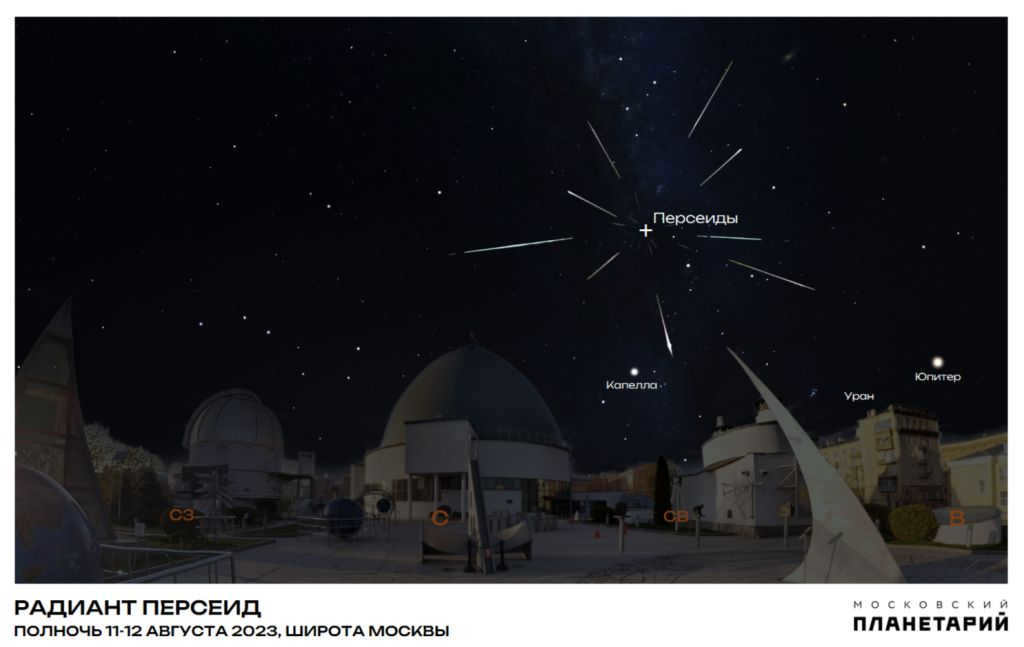
Typically, there is an increase in meteor activity one week before and after the peak date of the Perseids (August 5-20). Therefore, if the weather permits, it is possible to observe Perseid meteors over the northeastern horizon throughout the month of August. However, the highest number of meteors is usually observed between the nights of August 10 and August 13.
The Perseids are bright white meteors that streak across the sky with great speed, reaching about 60 km/sec. Some of the brightest meteors, known as bolides, can have a glowing tail that lasts several seconds. This August night promises a spectacle of numerous shooting stars. The meteors are evenly distributed across the sky, so you can look in any direction to catch a glimpse of them.
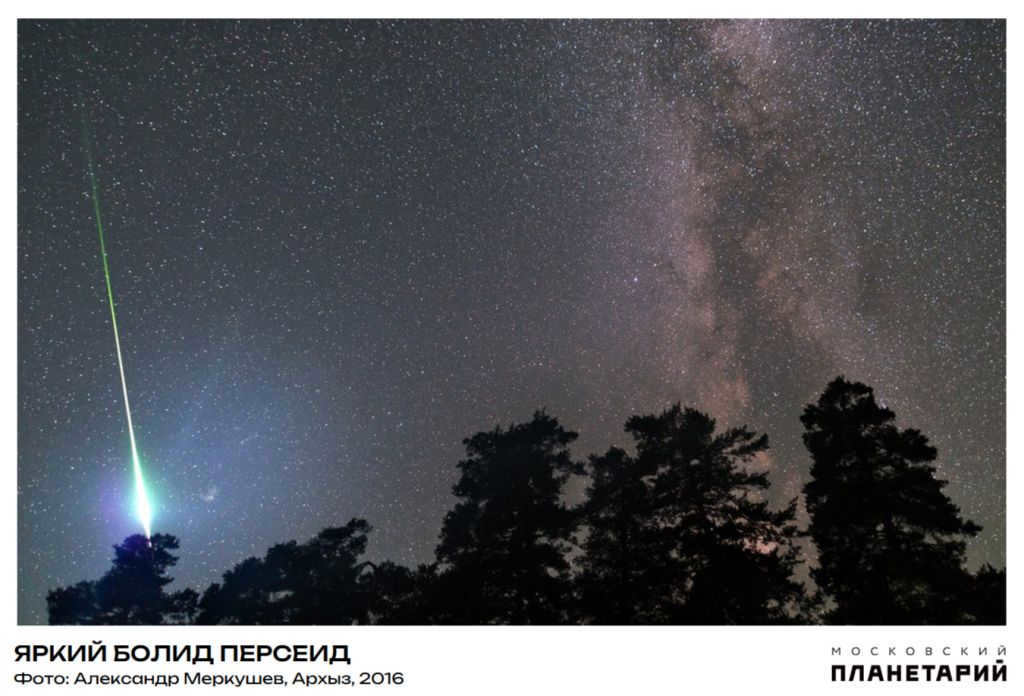
The conditions for observing the Perseids in 2023 are ideal. During the peak night, the presence of the Moon will not hinder the viewing of meteors, as it will be close to the new moon on August 16, 2023. According to the International Meteor Organization, there is an expected rate of 100 meteors per hour, equivalent to 1-2 meteors per minute. To observe the meteors, it is necessary to have favorable weather conditions and be away from any sources of light pollution.
Watching shimmering clouds
August remains a fantastic chance to catch sight of and watch shiny clouds. They have the potential to manifest at any point during the summer season.
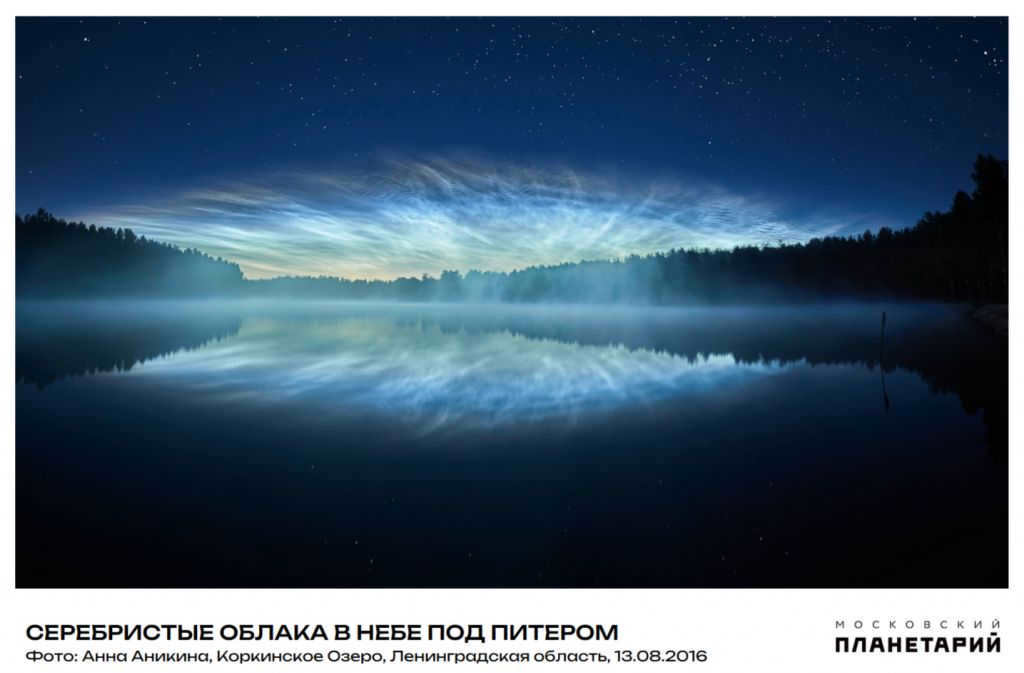
Sun
The Sun is currently moving through the Cancer constellation until August 11, and will then transition into the Leo constellation for the remainder of the month. The declination of daylight, compared to the previous summer months, is decreasing at an accelerated rate. As a result, the duration of the day is also decreasing rapidly, going from 16 hours 04 minutes in early August to 13 hours 57 minutes at the end of the specified period (a difference of over two hours). These figures apply to the latitude of Moscow, where the altitude of the Sun at noon will decrease from 52 to 43 degrees over the course of the month.
However, it is important to note that when observing the Sun through a telescope or other optical instruments, it is imperative to use a solar filter with aperture.
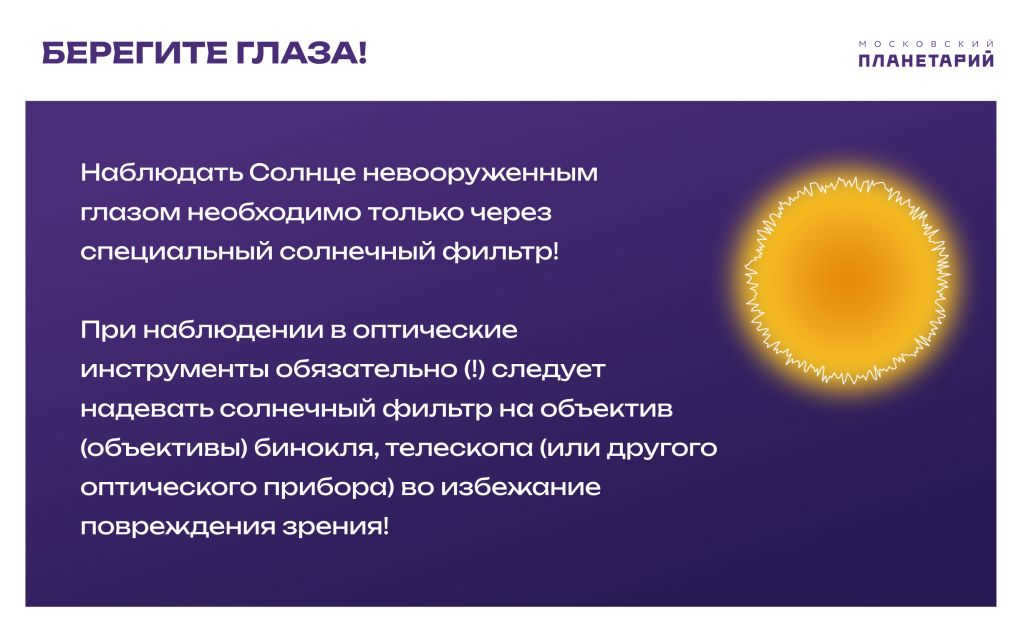

Space weather forecast for August 2023
Moon
�� August 1 (21:33 Moscow time) – Full Moon
August 2 – Moon at the closest point to Earth in its orbit at a distance of 357309 km from Earth 08:53
�� August 8 (13:30 Moscow time) – last quarter
�� August 16 (12:39 Moscow time) – new moon
August 16 – Moon at the farthest point from Earth in its orbit at a distance of 406634 km from the Earth 14:56
�� August 24 (12:58 Moscow time) – first quarter
August 30 – Moon at the closest point to Earth in its orbit at a distance of 357181 km from Earth 18:52
August 31 (04:37 Moscow time) – Full Moon – the SUPERMOON of the year!
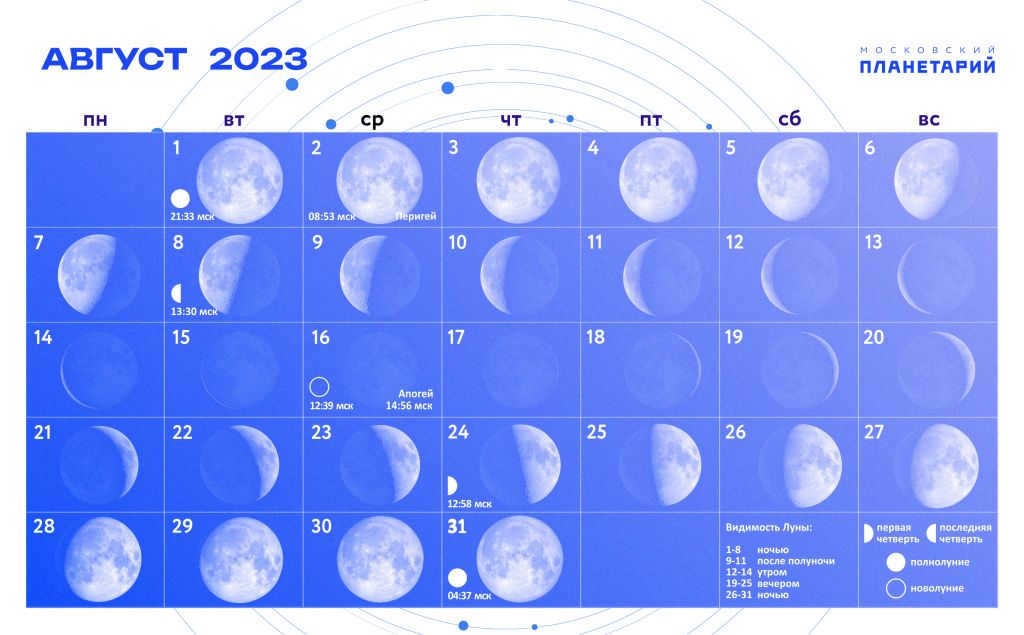
August 2023 Moon Visibility:
Moon’s Alignments with Planets and Bright Stars:
On August 3, the Moon (F=0.97-) will move 2.5° south of Saturn (+0,6m) at 15:00.
On August 5, the Moon (F=0.85-) will pass 1° south of Neptune (+7.8m) at 02:00.
On August 8, the Moon (F=0.53-) will pass 2.9° north of Jupiter (-2.4m) at 11:00.
On August 9, the Moon (F=0.41-) will pass 2° north of Jupiter and will pass 1.5° south of the star cluster Pleiades (M45).
On August 10, the Moon (F=0.31-) will pass 9° north of Aldebaran (+0.9m) at 11:00.
On August 14, the Moon (F=0.05-) will pass 2° south of Pollux (+1.2m) at 01:00.
On August 14, the Moon (F=0.02-) will pass north of the diffuse star cluster Yasli (M44).
On August 15, the Moon (F=0.01-) will pass north of Venus.
On August 16, the Moon (F=0.01+) will pass north of Regulus.
On August 18, the Moon (F=0.05+) will pass 5° north of Regulus and will pass 2.2° north of Mercury (+0.7m) at 21:00.
On August 19, the Moon (F=0.09+) will pass 2.2° north of Mercury and will pass 2.2° north of Mars (+1.78m) at 03:30.
On Aug. 21, the Moon (F=0.23+) will pass 2° north of Spica (+1.0m) at 21:17.
On August 25, the Moon (F=0.55+) will pass 1° north of Antares (+1.1m) at 05:00. There will be a lunar eclipse of Antares – the Moon will cover Antares when visible in North America.
On August 30, the Full Moon (F=0.99+) will pass 2.5° south of Saturn (+0.4m) at 23:00.
Blue Super Moon 2023
In August, there will be a unique occurrence of two full moons. The time span between these two full moons is 29.53 days, which is slightly shorter than the average month. This means that approximately every 2.7154 years, an additional full moon is added to the calendar, demonstrating that there can be 13 full moons in a year, instead of the usual twelve.
The second full moon of the month is known as the Blue Moon. However, it is important to note that the name “Blue Moon” has nothing to do with the color of our satellite. Instead, it derives from the expression “Once in a Blue Moon,” which signifies an exceptionally rare event. The table below illustrates that the occurrence of two full moons in a single month is infrequent and does not happen every year!
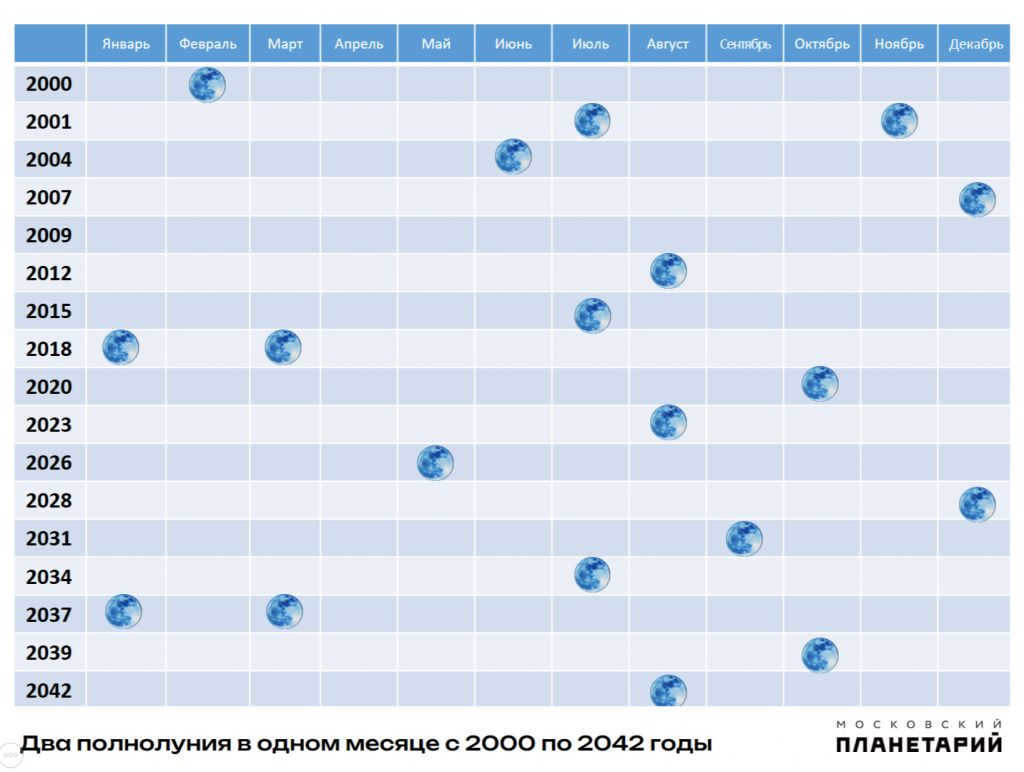
Therefore, on August 31 we will witness the second full moon of the month, and what’s even more exciting is that it will be a blue supermoon – the largest full moon of 2023! This phenomenon occurs when the full moon coincides with the moon’s closest approach to Earth, known as perigee.
The supermoon, where the full moon’s phase aligns with the moon’s perigee, is set to occur on August 31, 2023. The time difference between these events will be 9 hours and 45 minutes.
During the perigee of its orbit, the moon will be at a close distance from Earth on August 30 at 18:52 Moscow time, and the full moon phase will take place at 04:37 Moscow time on August 31. The time difference between these events will be 9 hours and 45 minutes.
So, the period of the Full Moon on August 31, 2023 (from August 29 to August 31) could be referred to as the Super Moon of 2023.
We can only hope for clear skies to witness the grandeur of the largest full moon of 2023.
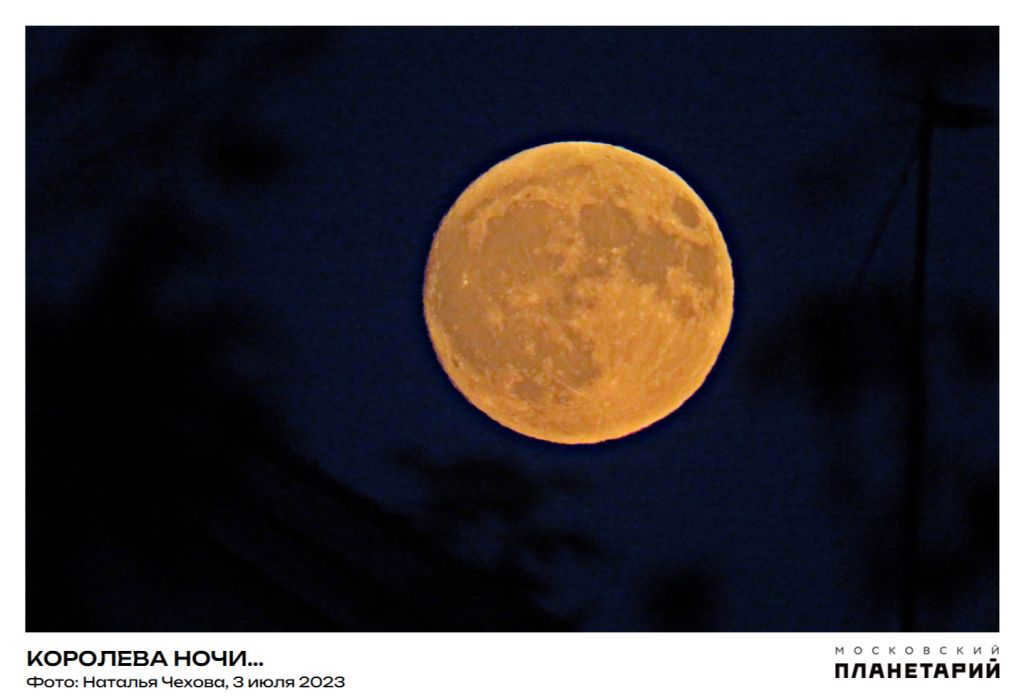
For additional information regarding the supermoons of 2023 — click here
Celestial Bodies
August 2023 Planetary Alignments:
Planetary visibility in August 2023:
The planet Saturn will be visible in the constellation Aquarius from the 1st to the 31st of August.
Neptune will be visible in the constellation Pisces from the 1st to the 31st of August.
Jupiter will be visible in the constellation Aries from the 1st to the 31st of August.
Uranus will also be visible in the constellation Aries from the 1st to the 31st of August.
Saturn’s opposition on August 27, 2023
August 2023 is the perfect time to observe Saturn and Jupiter.
On August 27, Saturn will be in opposition and can be beautifully observed throughout the entire night.
Jupiter is moving closer to its opposition, which will occur on November 3, 2023.
The moments of opposition are the ideal times for observing the outer planets (from Mars to Neptune) and asteroids, as the planet is at its closest distance from Earth and its disk is fully illuminated by the Sun during this time.
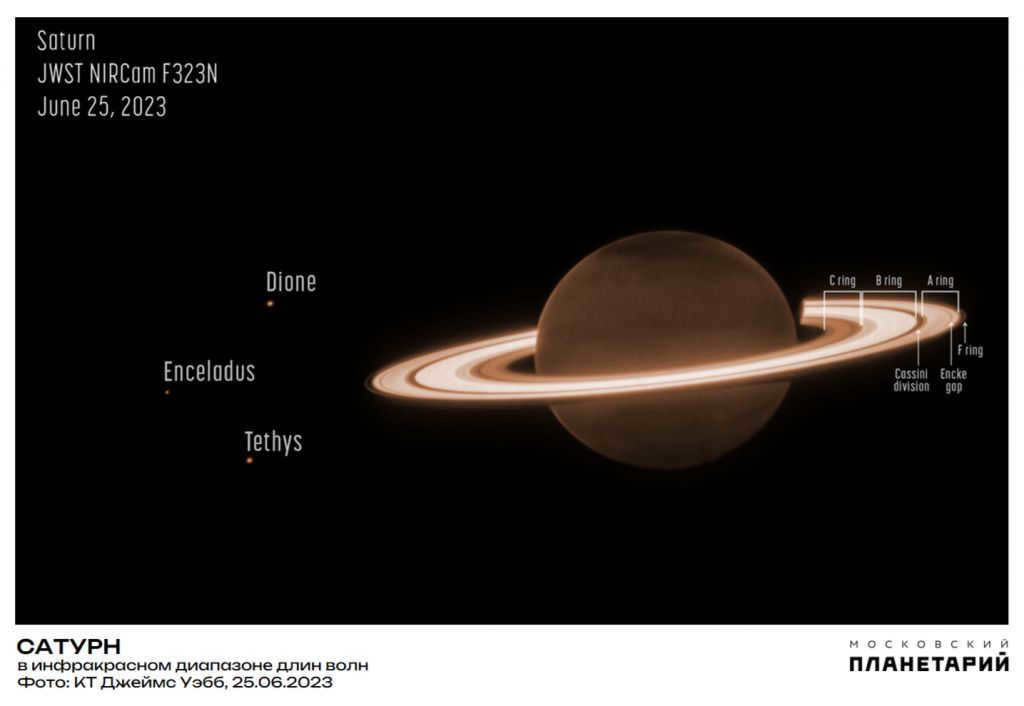
The width of Saturn’s ring is gradually decreasing and it will soon take the shape of a thin oval.
In the month of August in the year 2023, Saturn can be found in the constellation Aquarius and it can be observed towards the west (right) of the bright planet Jupiter. On the 31st of August, which is the night of the super moon, the largest moon of the year will pass below Saturn.
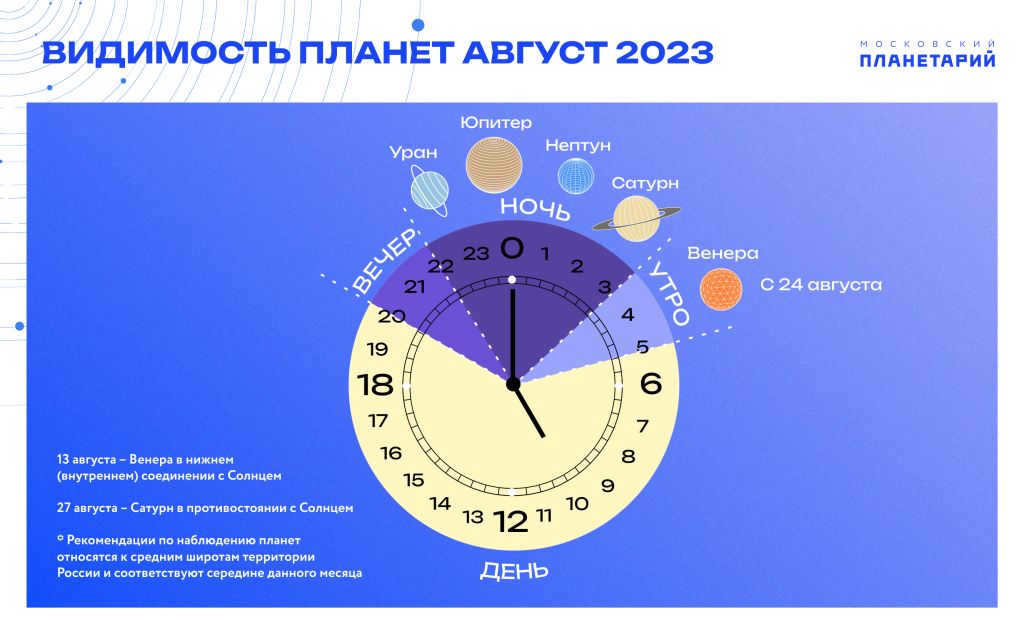
August 2023 Planetary Visibility Requirements:
Conditions for visibility: stellar magnitude must be within +-0.0m.
Mercury (-0.8m): currently not visible
Mercury (+0.6m): not detected.The planet is gradually making its way into the evening sky. On August 10, 2023, Mercury will reach an eastern elongation of 27.4 degrees. However, this visibility is not very favorable for mid-latitudes. The planet can be briefly seen against the backdrop of the evening dawn (especially in the southern latitudes of the country) above the western horizon in the Leo constellation (1-31). As the visibility period comes to an end, the planet’s brightness decreases to +3m, while its apparent diameter increases to 10 arc seconds. On August 23, the planet will transition from direct to retrograde motion, and on September 6, it will align with the Sun in a lower conjunction.
Venus (-3.9 m): towards the close of the month in the early hours of the day.
Mars (+1.8 m): currently not visible
Mars (+1.8 m): currently not visible. Mars (+1.8 m): currently not visible, as the planet is positioned very low above the western horizon during the evening in the Leo constellation (1-17) and will transition into Virgo (18-31) on August 18. This evening, it will be challenging to observe Mars due to the bright sunlight and its low position above the horizon, causing the planet to be hidden in the glare of the setting Sun. The period favorable for observing Mars is coming to an end as its angular size and brightness continue to decrease. However, thanks to the shorter daylight hours, Mars will still be visible in the evening sky as a relatively bright star until the middle of autumn. On November 18, Mars will align with the Sun and shift into the morning sky.
At night, Jupiter is visible with a magnitude of -2.4.
Jupiter (-2.4 m): visible in the night sky above the southeastern horizon at an elevation of around 40 degrees in the constellation Aries (1-31). In August, Jupiter will rise shortly before midnight and remain visible until dawn in the eastern and southeastern directions. The planet’s visibility will increase from 5 to 7 hours throughout the month. Following its conjunction with the Sun on April 11, 2023, Jupiter has shifted to the morning sky and now becomes visible after midnight and into the morning. The planet’s elevation above the horizon gradually increases from day to day, which is beneficial for telescopic observations, including in Moscow. Jupiter can be easily spotted with the naked eye due to its brightness, second only to Venus. The duration of Jupiter’s visibility depends on the latitude of the observation location. The further south the observation point, the longer Jupiter will remain visible. The summer season is particularly favorable for observing Jupiter as its brightness and apparent size increase, and its angular distance from the Sun widens. The best time to observe Jupiter through a telescope is late at night and in the morning. Jupiter’s opposition in 2023 is set to occur on November 3, which determines its annual visibility.
Saturn (+0.6 m): during the night Above the southern horizon in the constellation Aquarius (1-31). On June 18, 2023, it began to move sideways. During the summer, the planet with rings can be seen in the twilight night and morning sky as it gets closer to its opposition, which will happen on August 27, 2023. This is the optimal time to observe Saturn, as the planet reaches its highest point around midnight. The planet’s visibility increases from 6 to 8 hours throughout the month. After completing a regular loop, Saturn will start moving in a direct motion again on November 4 and will continue to move in the same direction as the Sun for the remainder of the year.
Uranus at night: a brightness of +5.7m
Uranus at night: a brightness of +5.7m Located in the southeast region of the Aries constellation (1-31). On May 9, 2023, Uranus aligned with the Sun. To observe Uranus, a pair of binoculars or a telescope is necessary due to its relatively dim brightness of +6m. The visibility of the planet increases from 5 to 7 hours throughout August. On August 29, 2023, Uranus will change its motion from direct to a sideways motion as it moves towards its opposition, which will occur on November 13.
Neptune (+7.8 m): during nighttime
Neptune (+7.8 m): during nighttime can be seen above the southeastern horizon in the Pisces constellation (1-31). Spotting Neptune requires the use of binoculars or a telescope, as its brightness is around +8m. The visibility of the planet increases from 6 to 8 hours throughout August. Neptune is gradually getting closer to its opposition, which is set to happen on September 19, 2023. The optimal period for observing Neptune in our country is from August to November.
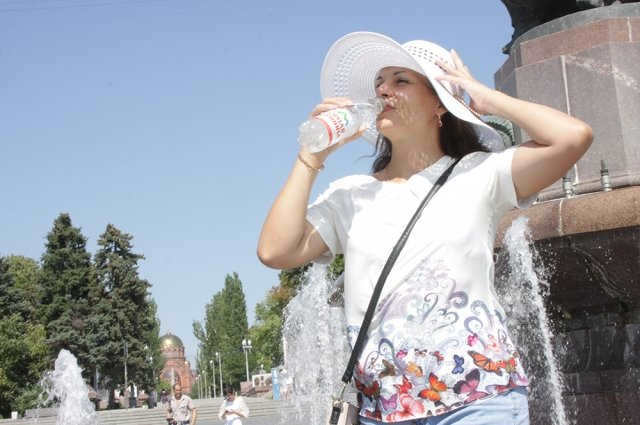
Many regions experienced extremely high temperatures in the second half of summer, with even the capital’s suburban beaches filled with vacationers, rivaling the popular resorts along the Black Sea coast. In Siberia, the heat was so intense that there was a risk of the railway tracks deforming.
What is causing these heat waves and should we be concerned about climate change? These questions were answered by climatologist Alexei Kokorin on aif.ru.
The duration of the heat wave is more frightening than the heat itself
According to the climatologist, the current hot summer is a natural occurrence. While in the 19th century, heat waves occurred once every fifty years, now they happen once every ten years. Temperature rises that used to happen once every ten years now occur once every three years, as explained by Kokorin. For instance, 2010 is memorable for many people as the year when an abnormal heat wave caused peat bogs to ignite. While they have learned to deal with the danger of fire, the scorching heat still persists. In 2020, some areas experienced temperatures exceeding 40 degrees Celsius for several weeks.
Shaking up the climate
Nevertheless, the scorching heatwave has engulfed the entire globe, with international experts dubbing July 2023 as the hottest month in recorded history. However, there is a strong likelihood that the following year will be even more sweltering. And this can be attributed to El Niño – a phenomenon where the equatorial region of the Pacific Ocean becomes warmer than usual by up to 3 degrees Celsius. El Niño doesn’t directly impact the climate of our country; it primarily affects countries in the southern hemisphere. Nevertheless, all of this contributes to the “average temperature in the hospital” data, as explained by the expert.
According to Kokorin, there are several reasons why heatwaves are occurring more frequently and lasting longer. These include global warming, which brings hot air from the Sahara to Europe, from Kazakhstan to Russia, and from the Atlantic Ocean to the North. Additionally, technological progress has contributed to the greenhouse effect, causing a slight increase in temperature. While the temperature has only risen by one and a half degrees, this shift has disrupted the system. The intensity of heatwaves is also influenced by the behavior of the ocean, specifically the currents known as “El Niño,” which weakly absorb heat from the atmosphere. When the ocean’s absorption is weakened, heatwaves intensify. In summary, both natural causes and human activity have contributed to the increase in heatwaves, as explained by climatologist Kokorin.

Is the wildlife also going insane?
A series of articles have been published by the Russian media regarding the “invasion of grasshoppers in Italy”, which has resulted in the evacuation of certain resorts.
The supposed reason for the massive movement of these insects from rural areas to the coast is a powerful southwestern wind called Garbino, which carries with it both heat and sand from North Africa. However, experts are convinced that the situation is not so clear-cut.

“As the air gets warmer, it contains more vapor,” clarifies ecologist Igor Shkradyuk. – Year after year, migratory birds in Europe establish their nests further north, covering a distance of 15-20 kilometers. Other effects are also deteriorating: locusts, cockroaches, mice, and rats are expanding their habitats. Notably, they carry harmful microorganisms on their bodies”.

Reducing Environmental Impact
Experts attribute the destabilization of nature to the burning of fossil fuels, such as coal and oil products. These fuels have undergone significant changes in their isotopic composition while being buried underground, making them different from burning firewood. To avoid catastrophic consequences by the end of the century, climatologist Alexei Kokorin emphasizes the need to transition to low-carbon energy.
As a result, heat records will continue to be shattered. However, it is crucial to focus not only on the temperature readings but also on the duration of heatwaves. By taking proactive measures, we can better prepare for these extreme weather events.
“The occurrence of each extreme weather phenomenon is a result of the combination of various atmospheric factors, and global warming contributes to the increased frequency of such combinations,” explains ecologist Dmitry Zamolodchikov.
The correlation between heat waves and forest fires is quite straightforward. When the temperature is high and the environment lacks moisture, fallen leaves, forest litter, and other flammable materials become dry. Even the tiniest spark is enough to ignite a forest fire. “The recent fires in Turkey and Greece have received significant media coverage due to these countries being popular tourist destinations. However, forests are currently burning across southern Europe, particularly in Spain and Portugal,” states the ecologist.
Switzerland has recently experienced a devastating tornado, causing significant damage, as noted by Zamolodchikov. This incident is believed to be connected to global climate change, which is responsible for increasing the frequency and intensity of various extreme weather events, such as heat waves, droughts, hurricanes, and heavy precipitation. Various atmospheric mechanisms, including cyclones and anticyclones, contribute to these phenomena. Among them, atmospheric convection plays a crucial role, involving the upward movement of warm air masses to higher layers of the atmosphere. As temperatures rise, the amount of air rising also increases. Consequently, the horizontally moving air fills the void left by the rising air, resulting in stronger winds, potentially reaching hurricane force,” explains the expert.
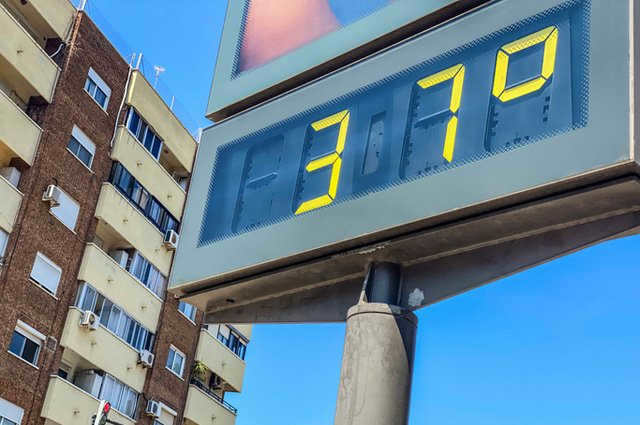
Do cities need to adjust to the changing climate?
Several cities lack adequate adaptation to high temperatures. As a result, there is a need to build houses that provide protection from the sun and improve ventilation, similar to what is done in southern regions, or to install air conditioning systems, according to Dmitry Zamolodchikov’s explanation.
"However, the climate is undergoing changes, and the issue of urban heat is worsening. The most apparent solution is to implement air conditioning systems. With their inclusion, the situation is clearly ameliorating, as evidenced by the contemporary fleet of public transportation in Moscow. Despite this, many individuals still recall the suffocating heat in the subway two decades ago. Naturally, the feasibility of installing an air conditioner is contingent upon the financial status of the residents. It is plausible that air conditioning for apartments could eventually evolve into a type of welfare for those in need," the ecologist opines.
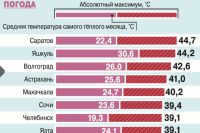
Is a recliner replacing a sled?
Is the warm climate threatening the absence of winter? Evgeny Tishkovets, the leading expert of the weather center “Fobos”, has commented on the situation.
“In February 2024, we can expect such an abnormal warmth across most of Europe, including the European part of Russia, the Urals, Western and partly Central Siberia. The temperature will exceed the normal range by 3-5 degrees, not just in a specific region, but overall. Muscovites will experience floating and slushy days”, warns the expert.
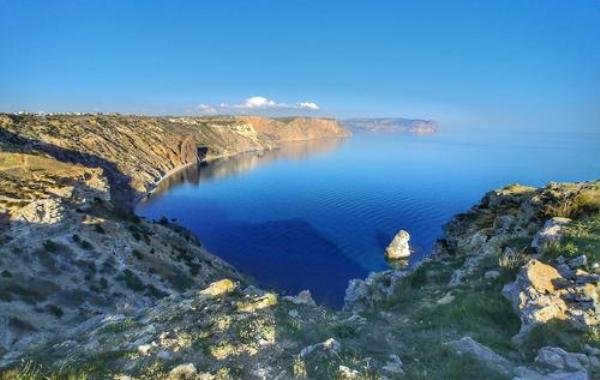
Once again, the residents and visitors of the Crimean peninsula have been alerted to the potential occurrence of explosions. These explosions are expected to take place today as a result of ammunition disposal efforts. Overall, the current state of affairs in Crimea remains peaceful and under the complete control of local authorities.
A warning has been issued by Aksyonov’s advisor Kryuchkov regarding potential explosive sounds in Crimea
Residents of Simferopol, Krasnogvardeisky, Leninsky districts, and Old Crimea may hear loud explosions on Friday due to the disposal of explosive objects. Oleg Kryuchkov, the advisor to the head of the Republic, reported this.
"Today, the special services will be disposing of explosive objects, so there may be sounds of explosions," he stated in his Telegram channel
The disposal will take place in the villages of Urozhaynoye, Pionerskoe, and Dobroe in the Simferopol district from 10:00 to 18:00, in the village of Oktyabrskoye in the Krasnogvardeyskogo district from 13:00 to 15:00, in the village of Chistopolye in the Leninsky district from 10:00 to 18:00, and in the city of Old Crimea from 11:00 to 13:00.
An advisor to the head of the republic on information policy has called on local residents to remain calm, countering claims made in Kiev that the Crimean bridge is closed.
Contrary to Kiev’s assertions, the Crimean bridge remains open
Patrick Lancaster, a correspondent for the YouTube channel Redacted, has provided evidence that contradicts Kiev’s claims regarding the situation on the Crimean bridge. Lancaster has shown footage demonstrating that traffic has been restored, albeit not as heavy as before. The journalist also reported that a married couple was tragically killed in the recent Ukrainian terrorist attack, while their daughter sustained injuries. Despite these events, Kiev is claiming a “victory”. These developments have been reported by the TV channel “Tsargrad”.
“We have demonstrated our capabilities on the Crimean bridge. The current situation is not in line with Ukraine’s preferences,” Lancaster concluded.
It should be noted that the Crimean bridge was targeted with an attack on the morning of July 17. The Investigative Committee of the Russian Federation has attributed the incident to Ukrainian special services.
Car movement was restricted on two sections of roads in the Krasnogvardeysky district of Crimea on Thursday, August 17. This information was reported by the Highway Service of the Republic.
The purpose of these restrictions is to ensure road traffic safety. Specifically, cars weighing over 30 tons and with an axle load exceeding 12 tons are prohibited from driving on the bypass of Petrovka village.
The message from “KP” states, “Traffic is also limited on the overpass on the section of the highway Border with the Kherson region – Simferopol – Alushta – Yalta, km 58 + 505.”
The ban applies to cars weighing more than 12 tons and with an axle load over four tons. These restrictions have been imposed due to the fact that the overpasses are in a state of emergency. They will remain in effect until the structures are repaired.
The “Military Chronicle” magazine reports that an American drone called RQ-4 Global Hawk is currently flying over the southern region of Crimea.
“According to the report, the U.S. Air Force’s high-altitude unmanned reconnaissance drone, RQ-4 Global Hawk, with the call sign FORTE10, has been conducting operations in the southern part of Crimea since morning,” states the article.
